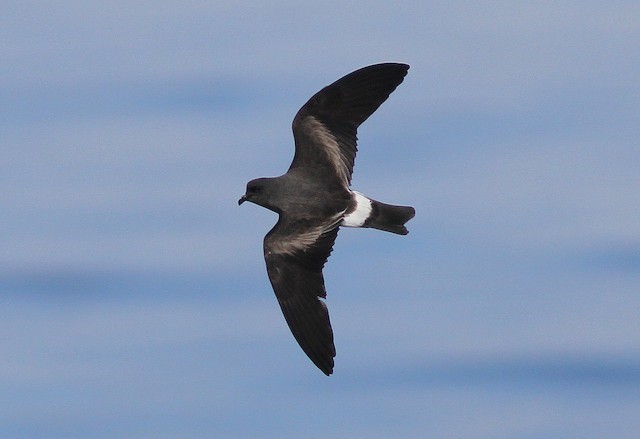Birdfinding.info ⇒ Recently described and little-known, Monteiro’s Storm-Petrel is locally common in the central Azores from late March into October. Most sightings are in the waters east of Graciosa, especially at Fortuna Bank. The largest known colony is on Ilhéu de Praia, which lies about 1 km offshore from the port town of Praia—however, the adults attend the colony nocturnally and are rarely seen from the town during daylight hours.
Monteiro’s Storm-Petrel
Hydrobates monteiroi
Endemic to the Azores; range at sea unknown.
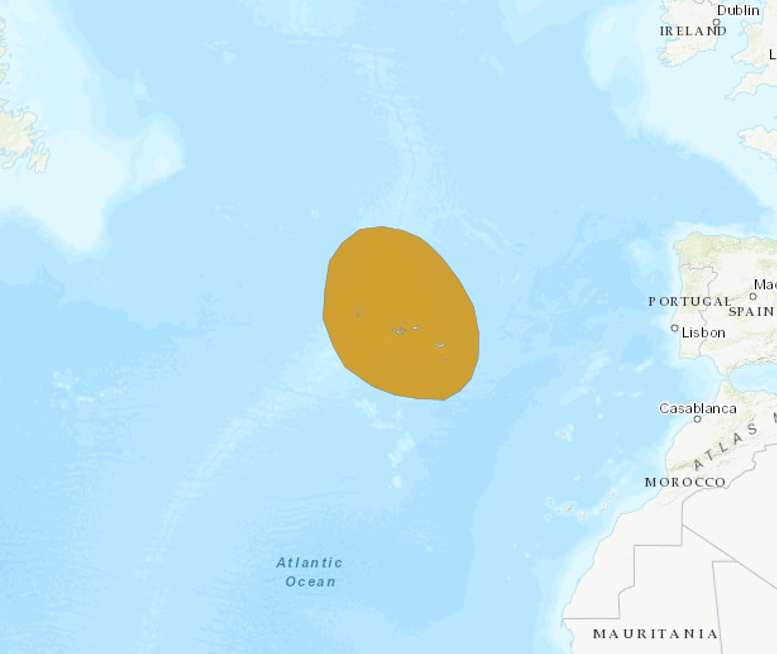
Conjectural at-sea distribution of Monteiro’s Storm-Petrel. © BirdLife International 2018
Breeds mainly on islets adjacent to three or four of the main Azorean islands. The majority (~300 pairs) nest near Graciosa on Baixo, Baleia, and Praia islets. Smaller numbers nest on islets near Flores, and are suspected of breeding around Corvo, and possibly also around São Miguel (detected nearshore in summer).
The breeding season is approximately March to October. Adults return in March and lay their eggs in May or June, with a few in early July. Juveniles fledge in late August and September, with a few in early October.
There appear to be no confirmed records outside of the Azorean archipelago. Tissue sample evidence of its winter diet reportedly suggests that it remains in the central North Atlantic, and is essentially non-migratory— unlike “Grant’s Storm-Petrel”, for which the comparable evidence corroborates its known migratory pattern. (These tissue samples were collected for the original research project that initially detected differences between the populations and ultimately led to the recognition of Monteiro’s as a separate species.)
Identification
As a cryptic species within the Band-rumped Storm-Petrel complex, Monteiro’s is visually indistinguishable from other band-rumped-type storm-petrels under most circumstances.
Its tail averages much more deeply notched than on “Grant’s”—the other band-rumped-type storm-petrel that breeds in the Azores—but can still appear square at some angles or when fanned. In the hand, Monteiro’s averages slightly smaller than “Grant’s” in most measurements, but with a slightly longer tail and proportionately longer wings. (Except for tail-notch depth, all of these metrics overlap widely.)
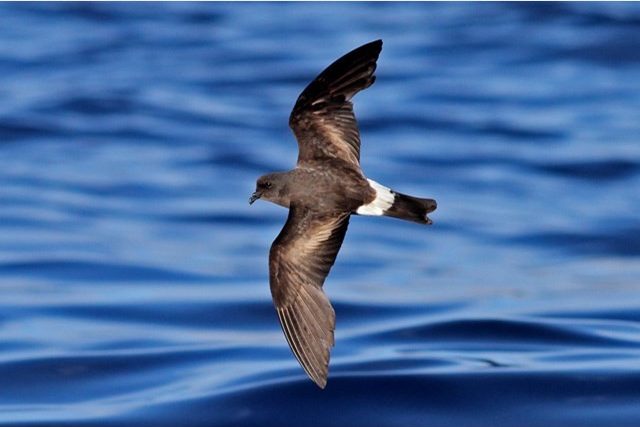
Monteiro’s Storm-Petrel, showing characteristically notched tail and molting secondaries—which is normal for an adult late in its breeding season. (Banco da Fortuna, offshore east of Graciosa, Açores, Portugal; August 25, 2013.) © Richard Bonser
Like other band-rumped-type storm-petrels, Monteiro’s is dark-brown overall, with an even white band across the rump that usually extends partway down the sides of the rump to the undertail.
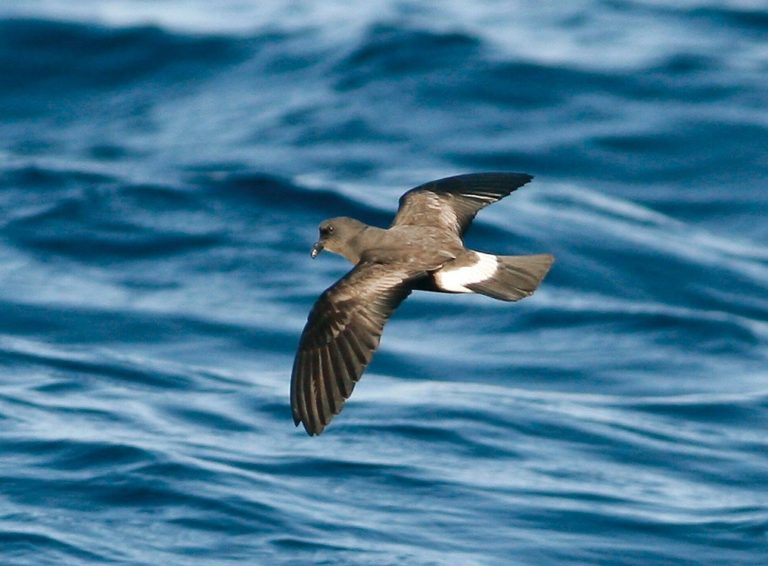
Monteiro’s Storm-Petrel—identification presumed based on location and season, despite lack of visible tail notch in this view. (Offshore southeast of Graciosa, Açores, Portugal; May 26, 2007.) © Killian Mullarney
As with most dark storm-petrels, all band-rumped-types typically show a paler brown or whitish diagonal stripe on the wing coverts, but the boldness varies depending on molt-stage and lighting. So the apparent color and boldness of the wingbar can provide clues to the age and molt-stage of closely observed individuals.
Juveniles and freshly molted adults have the most pronounced wingbars. On juveniles the bar appears white. On adults returning to the breeding grounds, the bar is blond. With feather-wear, the bar diminishes and can disappear entirely by the time the next molt begins.
For conditions where wing-molt can be discerned: adult Monteiro’s begins molting in late summer and completes in mid-winter; and first-year Monteiro’s would likely begin molting in May and complete in September (see Howell & Zufelt 2021). Note that this expected seasonality of feather-wear and replacement is effectively identical to that of “Madeiran Storm-Petrel”.
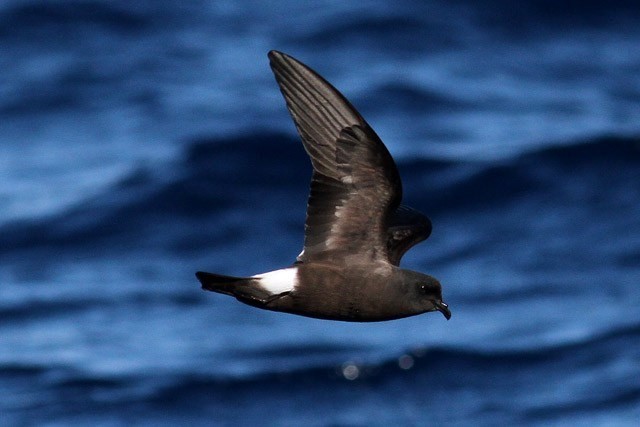
Monteiro’s Storm-Petrel—identification presumed based on location and season. (Offshore from Graciosa, Açores, Portugal; June 2, 2011.) © Richard Bonser
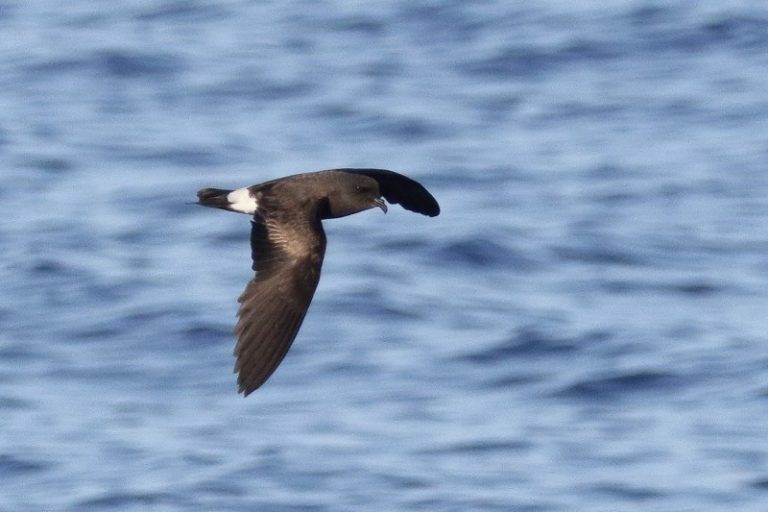
Monteiro’s Storm-Petrel, apparently molting secondaries late in the breeding season—as is expected for adult Monteiro’s in late summer. (Offshore from Graciosa, Açores, Portugal; September 1, 2019.) © François Stocman
Voice. Two types of calls are heard at breeding colonies: chattering and purring. Both resemble the equivalent calls of other storm-petrels, but differ in their patterns.
Monteiro’s’ chatter call is shorter and simpler than the calls of other North Atlantic band-rumped-types: typically comprising four to six notes, whereas the others vary from six up to sixteen (4 to 6 in Monteiro’s; 9 in “Grant’s”; 6 to 11 in “Madeiran”; 11 to 16 in Cape Verde).
Monteiro’s’ purring call consists of a rough purr or rattle followed by one or more “yelps” (less squeaky than other band-rumped-types, more like the scratch of a phonograph needle) with a brief gap between the purr and the yelp: (For a detailed review with more recordings and sonograms, see The Sound Approach: Monteiro’s Storm-Petrel.)
Notes
Monotypic species. Formally described in 2008 (Bolton et al.), following the discovery in the mid-1990s that two populations that both appeared to be Band-rumped Storm-Petrel (H. castro) were breeding in the Azores at different seasons, subsequent studies that found consistent differences in structure, voice, and foraging habits, and genetic analyses showing that the populations had diverged between approximately 70,000 and 150,000 years ago.
IUCN Red List Status: Vulnerable.
See below for comparisons of Monteiro’s Storm-Petrel with “Grant’s Storm-Petrel” and other Atlantic members of the Band-rumped Storm-Petrel complex.
Cf. “Grant’s Storm-Petrel”. Among the many populations of storm-petrels that were formerly classified together as Band-rumped, the first discovery of a “cryptic species” distinction was between the two populations that breed in the Azores: one in the hot season (Monteiro’s, which lays its eggs between early May and early July), the other in the cool season (“Grant’s”, which lays between early October and early December). Monteiro’s is not known to occur anywhere besides the Azores and surrounding seas, whereas “Grant’s” also breeds on other island groups east to the Berlengas and south to the Canaries, and migrates to the western North Atlantic and Gulf of Mexico.
Within the Azores, around their shared breeding grounds, Monteiro’s and “Grant’s” overlap en masse twice. First in spring, during March and April, both are present in the area: Monteiro’s arrives while “Grant’s” departs. Second in late summer, from mid-August into early October, both occur at the colonies, with “Grant’s” replacing Monteiro’s. At this time they have been observed in the same burrows—with “Grant’s” prospecting sites still occupied by fledgling Monteiro’s.
Due to the close relationship between them and the intensive research that led to their recognition as separate species, they have been compared more closely than other Band-rumped forms. See the biometric data compiled in Table 1, below, from Bolton et al. 2008—the paper that effectively proved their identities as separate species. Despite these robust comparisons, Monteiro’s and “Grant’s” can still be indistinguishable, even under optimal conditions.
Summarizing the differences: Monteiro’s averages slightly smaller in the body (e.g., weight and bill size), but slightly longer in the tail and wings. Tail fork depth is the most consistent visible differentiator, as Monteiro’s averages more than twice as deep: 7.81 mm for Monteiro’s versus 3.53 mm for “Grant’s”. Note that even these measurements overlap broadly (1 to 14 mm for Monteiro’s versus 0 to 7 mm for “Grant’s”), while all other recorded metrics overlap far more than they differ.

Table 1 from Bolton et al. 2008, comparing measurements of >100 “Grant’s Storm-Petrels” (the cool season population) and >200 Monteiro’s Storm-Petrels (the hot season population).
In spring and late summer in the Azores, Monteiro’s and “Grant’s” differ in their predominant molt-stages, although the differences are difficult to specify and apply. At the end of their breeding season, the adults of one population should appear either worn or visibly molting. Conversely, at the beginning of their breeding season, most adults of the other population should be near the middle of their cycle—not visibly worn, nor molting. These distinctions can be helpful in context, but several factors counsel against heavy reliance on molt-stage: i.e., the wide variability of feather-wear and replacement, along with the likely presence of some first-year birds and the possible presence of other Band-rumped forms.
Cf. Other Atlantic Band-rumped-type storm-petrels. At least six cryptic species or forms in the Band-rumped Storm-Petrel complex have been recognized in the Atlantic. Four breed on North Atlantic archipelagos of Macaronesia and two on widely scattered islands of the South Atlantic. Apart from their breeding grounds, the ranges of these forms remain mostly unknown. Sightings are scarce and the forms are extremely difficult to distinguish from one another at sea.
The four North Atlantic forms overlap with one another to varying degrees and are known to differ vocally. In brief, all four have two similar call types—chattering and purring—which vary in length, pattern, and complexity. Differing calls have helped to confirm their respective breeding distributions, but they generally call only on the breeding grounds and only at night.
In most cases, under most conditions, the visual differences among the forms are too subtle and inconsistent for field identification. With that caveat, following is a summary of factors that might help in exceptional circumstances—the forms are listed by the average latitudes of their breeding grounds, from north to south.

Cape Verde Storm-Petrel—identification presumed based on the location, far out at sea south of Cape Verde, though any of the Atlantic band-rumped forms could occur there at any time of year. (May 4, 2011.) © Graham Ekins
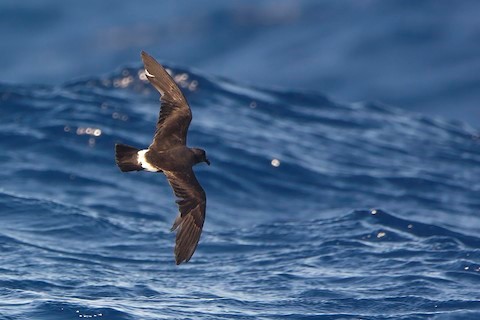
“Madeiran Storm-Petrel”, H. c. castro —likely this subspecies, based on molt-stage, season, and location within its known breeding range—but these factors are also consistent with Monteiro’s, Cape Verde, and first-year “Grant’s”, all plausible alternative identifications. (Offshore northeast of Lanzarote, Canary Islands, Spain; November 1, 2014.) © Miguel Rouco
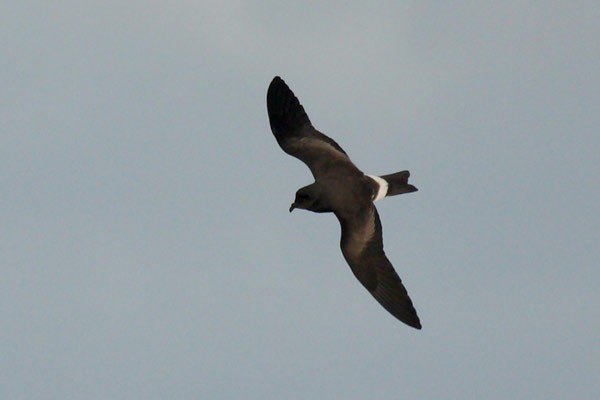
Monteiro’s Storm-Petrel—based on large samples of measured individuals at their Azorean breeding sites, Monteiro’s tends to have a more deeply notched tail than “Grant’s”, but their measurements overlap. (Offshore from Graciosa, Açores, Portugal; May 2011.) © Gareth Knass

“Gulf of Guinea Storm-Petrel”, H. c. ssp. nova, showing apparently thin rump-band and long-looking tail. © William H. Wagstaff
Monteiro’s Storm-Petrel (monteroi): Breeds in the Azores from March to October (eggs laid from early May to early July). Gives the shortest, simplest calls, with a rougher, scratchier quality than the others. Relatively small-bodied, long-tailed, and long-winged, and usually has a visibly notched tail.
“Grant’s Storm-Petrel” (ssp. nova): Breeds from the Azores east to the Berlengas and south to the Canaries from August to April (eggs laid from early October to early December). Calls end with signature punctuation. Relatively large and robust, and has a squarish or shallowly notched tail. Post-breeding adults show heavy feather-wear and/or molting flight feathers most noticeably from April to June—when Monteiro’s and “Madeiran” are fresh-plumaged.
“Madeiran Storm-Petrel” (castro): Breeds in Madeira, the Selvagens, and the Canaries from April to October (eggs laid in June and July). Calls are squeaky, rapid, about intermediate in length between Monteiro’s and Cape Verde, and lack the particular ending of “Grant’s”. Relatively small and slim overall; tail can appear either square-tipped or notched.
Cape Verde Storm-Petrel (jabejabe): Breeds in Cape Verde over an extended season, possibly year-round with two peaks—one from October into winter, the other from April into summer. Gives the longest, most complex calls, and genetic analyses indicate that it is the oldest divergent lineage in the band-rumped complex. Proportions are average, and has a squarish or shallowly notched tail.
“Gulf of Guinea Storm-Petrel” (ssp. nova): Breeds on São Tomé over an extended season, possibly year-round. Calls are relatively long and complex, suggesting an affinity with Cape Verde. Appears slightly larger than other forms, with a narrow white rump band and long-looking squarish or shallowly notched tail.
“St. Helena Storm-Petrel” (helena): Breeds on St. Helena and Ascension in two seasons—possibly multiple distinct forms or cryptic species—one from October to March, the other from April to September. Attends the nest diurnally. On some individuals the white rump band extends far down undertail coverts. Slightly larger than most other forms; usually shows a visibly notched tail.
Additional Photos of Monteiro’s Storm-Petrel
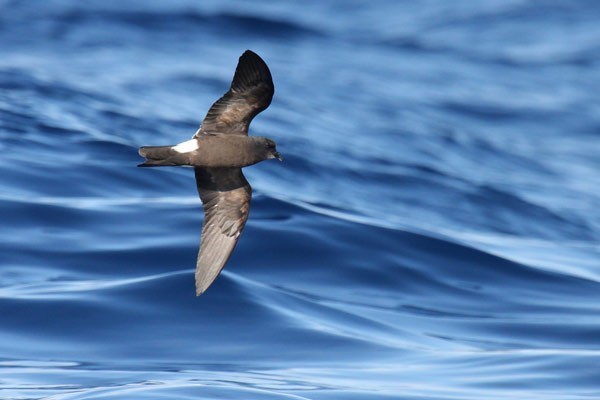
Monteiro’s Storm-Petrel. (Offshore from Graciosa, Açores, Portugal; June 2011.) © Gareth Knass
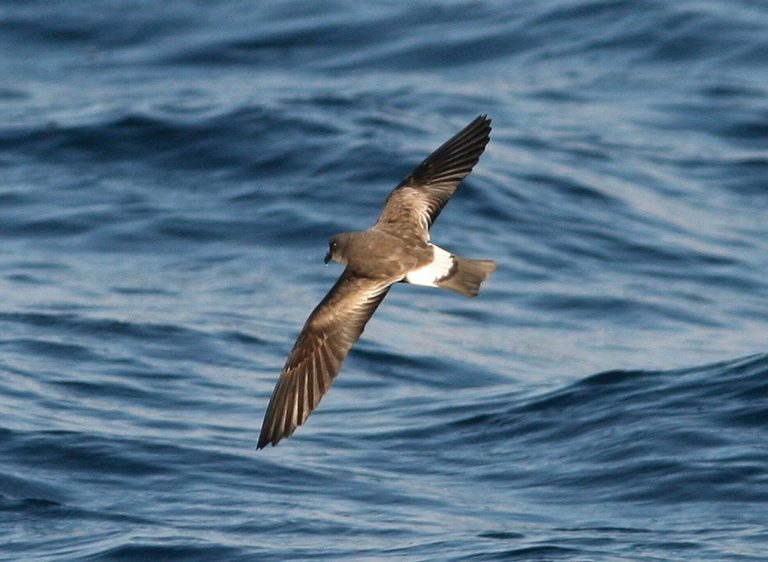
Monteiro’s Storm-Petrel. (Offshore southeast of Graciosa, Açores, Portugal; May 26, 2007.) © Killian Mullarney
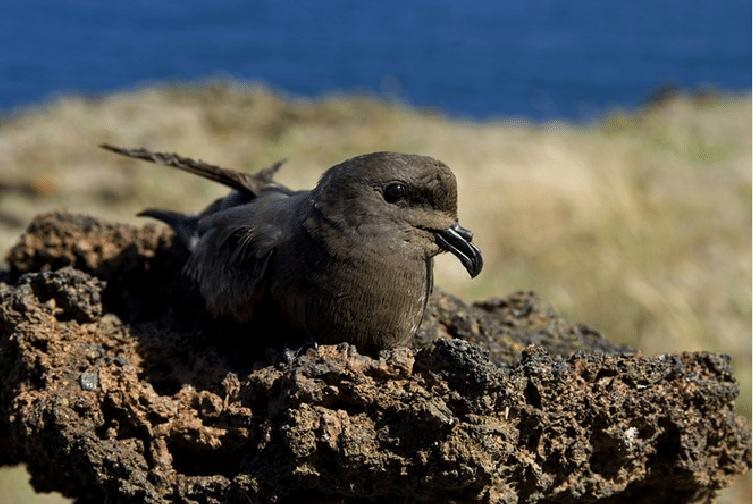
Monteiro’s Storm-Petrel. (Ilhéu de Praia, Graciosa, Açores, Portugal.) © Pedro Silva

Monteiro’s Storm-Petrel at breeding colony. (Ilhéu de Baixo, Graciosa, Açores, Portugal; June 8, 2021.) © Rúben Coelho
References
BirdLife International. 2018. Hydrobates monteiroi. The IUCN Red List of Threatened Species 2018: e.T22735624A132665118. https://dx.doi.org/10.2305/IUCN.UK.2018-2.RLTS.T22735624A132665118.en. (Accessed December 14, 2021.)
Bolton, M., A.L. Smith, A. L., E. Gómez-Díaz, V.L. Friesen, R. Medeiros, J. Bried, J.L. Roscales, and R.W. Furness. 2008. Monteiro’s Storm Petrel Oceanodroma monteiroi: a new species from the Azores. Ibis 150:717-727.
eBird. 2021. eBird: An online database of bird distribution and abundance. Cornell Lab of Ornithology, Ithaca, N.Y. http://www.ebird.org. (Accessed December 14, 2021.)
Garcia-del-Rey, E. 2011. Field Guide to the Birds of Macaronesia: Azores, Madeira, Canary Islands, Cape Verde. Lynx Editions, Barcelona.
Harrison, P. 1983. Seabirds: An Identification Guide. Houghton Mifflin, Boston.
Howell, S.N.G. 2012. Petrels, Albatrosses & Storm-Petrels of North America. Princeton University Press.
Howell, S.N.G., and K. Zufelt. 2019. Oceanic Birds of the World. Princeton University Press.
Onley, D., and P. Scofield. 2007. Albatrosses, Petrels & Shearwaters of the World. Princeton University Press.
The Sound Approach. 2019. Monteiro’s Storm-Petrel, Oceanodroma monteiroi. https://soundapproach.co.uk/species/monteiros-storm-petrel/.
Xeno-Canto. 2021. Monteiro’s Storm Petrel – Oceanodroma monteiroi. https://xeno-canto.org/species/Oceanodroma-monteiroi. (Accessed December 14, 2021.)
